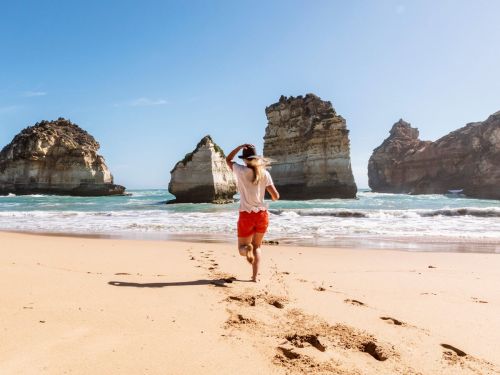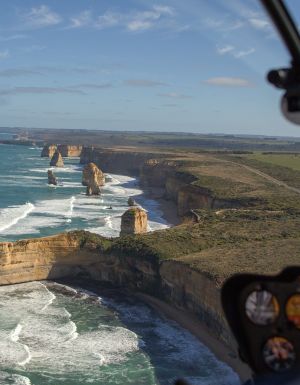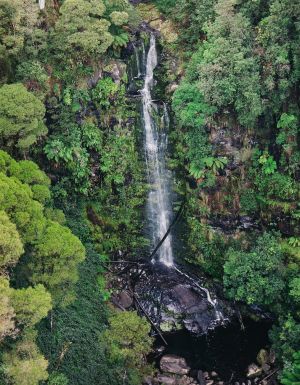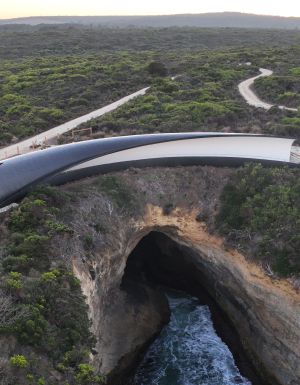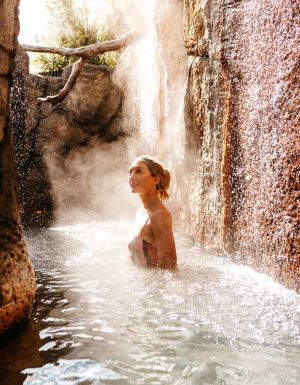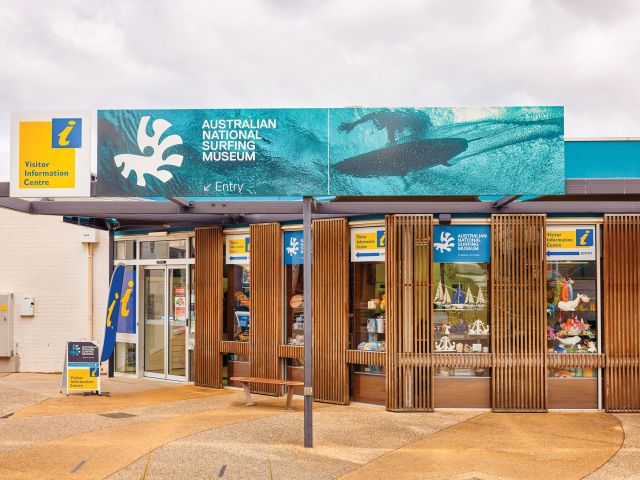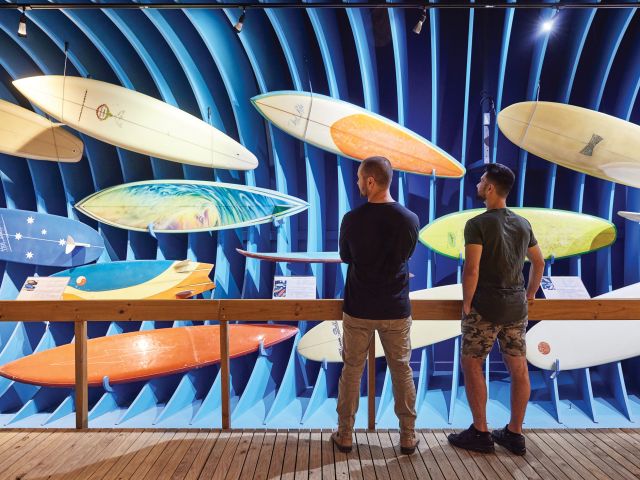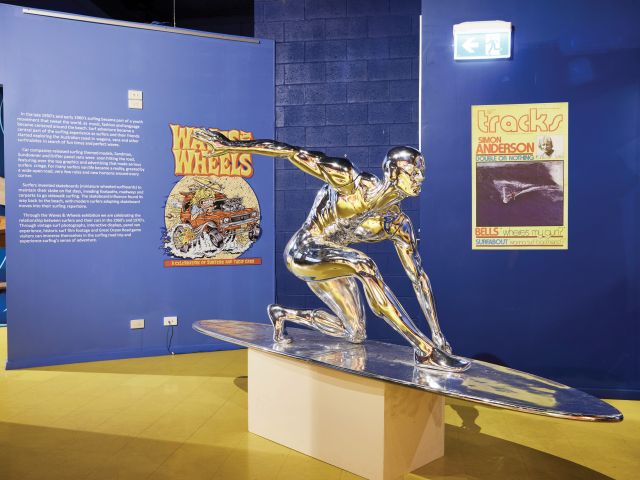If you’re planning a Great Ocean Road trip, there are plenty of places to stop and things to do while driving on one of the world’s most scenic roads.
Travelling to Victoria soon? Of all the things to do, Great Ocean Road exploration should be at the top of your list. The world-famous Great Ocean Road cuts its way through a bewitching limestone wilderness that is fringed by native bushland teeming with wildlife on one side and the wild beauty of the Southern Ocean on the other.
Along the 255-kilometre route, there is plenty to see and do: from watching humpbacks breaching from a coastal whale-watching platform to booking into a chocolate-making masterclass. Here are the places worth stopping at on the Great Ocean Road.
1. Take in the wild beauty of the Port Campbell National Park
One of the better-known highlights along the Great Ocean Road is the Twelve Apostles. Do not miss seeing this offshore collection of limestone stacks rising proudly out of the ocean, standing 45 metres high. The lookout is located within the Port Campbell National Park and taking time to marvel at them is a requirement of every journey to the region.

But don’t just stop at the Twelve Apostles. The Port Campbell National Park has plenty more natural attractions to explore, including London Bridge , an offshore natural arch located just a few minutes’ drive west of the Apostles. The stack, which was formed by a gradual erosion process, was connected to the mainland until 1990 when it collapsed to create a detached double-span natural bridge.

2. Get a sugar hit at Great Ocean Road Chocolaterie & Ice Creamery
Open every day except Christmas Day, this popular pitstop in Bellbrae is fun for all the family. Book a spot in the Chocolate Discovery class to craft your own chocolate bar and taste a selection of the chocolaterie’s finest or sit down for a decadent chocolate high tea in the private experience room. If you’re short on time and just want a bite to eat, the all-day cafe menu has a mix of savoury and sweet items, including waffles and croissants for brunch, burgers and stone-baked pizzas for lunch, and scones and old-fashioned sundaes for dessert.
3. Head to one of the famed lookouts
The Great Ocean Road provides much by way of rich scenic grandeur – best appreciated from one of the many viewing platforms you’ll find along the way.
Teddy’s Lookout
Take a short drive to the top end of George Street to find the renowned views of the Great Ocean Road sighted on many a Lorne postcard. It delights just as equally in person.
Logans Beach
Between June and September, female southern right whales return to Logans Beach in Warrnambool to birth their young. They often swim within a hundred metres of the shore and a specially constructed platform has been built to view them at play.

Cape Patton
Located between Kennett River and Wongarra, Cape Patton provides dramatic views of the windswept coastline. It marks the western end of what was considered the Great Ocean Road when first constructed by World War One veterans. A plaque at the lookout tells the story.

Twelve Apostles
Visit the Twelve Apostles at dawn or hang around after the sun goes down to see little penguins – they come ashore each evening on the beach at the base of the 70-metre cliffs.

4. Pay a visit to QDos Arts in Lorne
While Lorne mightn’t be known for its artistic prowess, one venue does well to showcase its unassuming talent. QDos Arts is a studio, gallery, cafe and sculpture park that specialises in fine and contemporary art. It’s the first space of its kind in the region, hosting many gallery exhibitions each year. There is also boutique accommodation onsite, with luxury Japanese-style tree houses perfect for couples or solo travellers.
5. Become a part of the local festival scene
The residents of the Great Ocean Road love a good bash – and visitors can expect a celebration for everything from folk music to seafood.
In March, the Port Fairy Folk Festival – or ‘folkie’ – transforms the historic fishing village into a four-day reverie of musical and theatrical delights. Feast on international and local folk, blues and roots artists alongside street theatre, comedy performances, interactive workshops and inspiring talks.

The Bonney Upwelling is the epic natural ocean occurrence that powers a seven-month feeding frenzy for the region’s marine animals. Upwelling Festival celebrates the commencement of this incredibly rich ecological food web with an epic one-day event. Held on the first Saturday in November, visitors and locals alike come for the music, market stalls and whale boat racing, and stay for the absurd street parade of aquatic ornaments and fish flags.
The Apollo Bay Seafood Festival is a great way to continue the marine celebrations. The gourmet extravaganza dishes up world-class, locally sourced seafood, straight from the ocean to the people. Take your pick of the morning catch direct from the fishermen, order food from the pop-up restaurants and drink your way through an extensive offering of craft beer, wine and cocktails.
6. Taste some of the Great Ocean Road’s finest
Located in the busy beach town of Torquay, the Great Ocean Road Gin distillery is open on select days seasonally. The owner, Ann Houlihan, uses local botanicals to produce her high-quality, small-batch gin. The citrus-forward Guvvos variety (named after a favourite surfing spot of Ann’s daughter) features a number of botanicals local to the Surf Coast region, including coast daisy, saltbush, pigface, kelp and indigenous eucalypts. Stop by the shop to grab a bottle of gin or some classic G&Ts in a can to take the edge off a warm summer afternoon.

7. Discover some under-the-radar natural gems
While the heavy hitters are definitely worthy of exploration, you should also consider adding some of these lesser-known gems to your itinerary. In summer, locals swim at Childers Cove . Drive 19 kilometres west of Peterborough and turn off the Great Ocean Road at Nirranda South to find its wonderful seascapes.

For striking limestone cliffs, dramatic rocks and relatively few people, try Bay of Islands and the Bay of Martyrs. Both are located near Peterborough and feature sprawling headlands to traverse and colourful wildflowers to admire, minus the heavy crowds that converge at some of the more famous sites during high season.

8. Take a surfing history lesson in Torquay
Torquay is world-renowned as Australia’s surfing headquarters – making it worthy of a spot on your Great Ocean Road hit list. The Australian National Surfing Museum on Beach Road (of course!) is a great place to start.

Learn about the history and evolution of the sport and gain an understanding of exactly how it cemented itself as part of our national identity.

If you’re a keen surfer, you’ll find plenty of action at Jan Juc, Torquay front and Torquay back beaches. Finding breaks suitable for intermediate or beginner surfers shouldn’t be too hard, but as always, watch the conditions and ask for advice if you’re unsure.

As the home of the famous Rip Curl Surfing Competition , Bells Beach is an iconic surf spot known around the globe.

Powerful Southern Ocean swells roll in over the shallow reef, giving visitors a front-row seat to the waves that draw thousands of surfers from around the world each year.

Watch local surfers ride the waves from one of the cliffside vantage points – the clifftop carpark has great views.
Top off your assimilation with a visit to one of the major surf brand giants that call Torquay home: both Rip Curl and Quicksilver have stores in town for you to visit to stock up on surf gear and summer threads.

9. Walk to Griffiths Island
This ruggedly beautiful one-hour walk in Port Fairy takes in secluded beaches, a shearwater colony and the old 19th-century lighthouse. It’ll guide you along all the best scenic locations of Port Fairy, past heritage buildings and old stone churches.

Named after John Griffiths, who established Port Fairy’s whaling industry on the island in the 1830s, the island is home to a shearwater bird colony. Each day they return in swarms to their nests after fishing out at sea. Be sure to keep on the walking track to avoid disturbing the nests burrowed into the sand.

10. Explore the Winter Whale Trail
If you’re travelling along the Great Ocean Road from May to September, be sure to keep the possibility of a whale sighting top of mind. During this period, it’s possible to spot migrating southern right whales, humpbacks, blue whales and even orcas if you’re lucky. There are some great vantage points along the trail, including the Logans Beach Whale Viewing Platform in Warrnambool, East Beach in Port Fairy and Wade Street Viewing Platform in Portland, although if you’re near the beach you could be blessed with a whale sighting at almost any time during this period – a solid reason to get along to the Great Ocean Road during the cooler months if ever there was one!
Discover the best restaurant along the Great Ocean Road.


